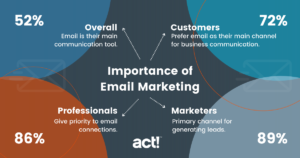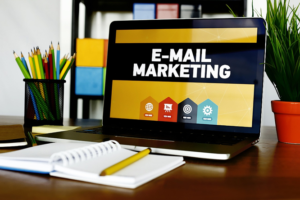What is email marketing?
The practice of sending targeted emails to a specific group of recipients to promote products or services and engage with the audience is commonly referred to as email marketing.
Businesses may engage with their customers, foster brand loyalty, increase sales, and offer useful content with the help of this effective tool.
Newsletters, promotional emails, transactional emails (like order confirmations), and drip campaigns are just a few examples of the different ways that email marketing campaigns can be conducted. Based on the recipient’s preferences, actions, and demographics, these emails can be tailored to make them more pertinent and efficient.
Building and maintaining your email list, producing engaging email content, audience segmentation, A/B testing to optimize emails, and tracking performance metrics like open rates, click-through rates, and conversion rates are all essential components of email marketing. Effective.
How does email marketing work?
An organized process with numerous crucial elements underlies how email marketing operates. Now, let’s provide a concise overview of email marketing in general
1.Create an Email List:
Making and expanding an email list of people who have shown interest in your company, products, or services is the first step in the process. This list can be generated using social media, events, websites with sign-up forms, or online shopping.
2.Making Email List Segments:
You divide your email list to make sure that your emails are pertinent to various recipient groups. Subscribers are categorized through segmentation based on things like demographics, activity, past purchases, and preferences.
3.Designing Email Content
Following the segmentation of your list, you create email content tailored to the wants and needs of each category. Text, photos, links, and calls to action (CTAs) can all be used in email content.
4.Create the email:
You create the email, paying attention to the visual appeal, mobile responsiveness, and layout. For this purpose, many email marketing systems offer templates and tools.
5.Email transmission:
You schedule the email to go out to the specified parts of your list using an email marketing tool. Emails can be sent instantly or scheduled to be sent at particular times or on particular dates.
6.Interaction with Recipient:
The email is delivered to subscribers’ inboxes. If the email’s content is interesting and pertinent to their needs, recipients will open it, click on the links, and take action (like completing a purchase).
7.Analytics and tracking:
Platforms for email marketing offer thorough statistics, enabling you to monitor the effectiveness of your communications. Metrics like open rates, click-through rates, conversion rates, and unsubscribe rates are all available for monitoring.
8.Automated Follow-Up :
Automation in email marketing might involve creating procedures for automated answers. For instance, drip campaigns allow you to send out a series of emails over time, react to certain triggers (like abandoned shopping carts), or present tailored information.
9.Optimization:
Based on the analytics and performance data, you continuously optimize your email marketing strategy. This involves refining content, subject lines, send times, and segmentation to improve results.
10.Compliance with Regulations:
It’s essential to ensure that your email marketing efforts comply with relevant regulations, such as the CAN-SPAM Act or GDPR. This includes obtaining consent, providing unsubscribe options, and respecting data privacy.
11.Iterative Process:
Email marketing is an iterative process. Marketers learn from each campaign and apply those insights to future efforts, gradually improving the effectiveness of their email marketing strategy.
Why is email marketing is important?

For a number of compelling reasons, email marketing is crucial, and many effective digital marketing strategies are built around it. Here are some reasons why email marketing is so important:
1.Direct communication:
Email offers a direct and individualized way for reaching your audience. Messages are delivered directly to recipients’ inboxes, guaranteeing that the appropriate audience will receive your content.
2.Broad Reach:
Email is a communication tool that is used by billions of people worldwide. You can interact with a huge and varied audience through it, whether that audience is local or far.
3. Cost effect:
One of the most cost-effective digital marketing methods is email marketing. All sizes of organizations can use it because it removes the costs of printing, postage, and advertising space.
4.Targeted Messaging:
Email marketing enables precise targeting. You can segment your email list based on demographics, behavior, purchase history, and preferences. This ensures that your messages are relevant to specific groups of subscribers.
5.Personalization:
Personalization is a powerful feature of email marketing. You can address recipients by their names, tailor content based on their preferences, and recommend products or services based on their past interactions with your brand.
6.Automation:
Automation tools allow you to set up drip campaigns, send automated responses to specific triggers (e.g., abandoned carts), and nurture leads over time. This saves time and ensures timely communication with subscribers.
7.Measurable Results:
Email marketing platforms provide detailed analytics, allowing you to track the performance of your campaigns. You can monitor open rates, click-through rates, conversion rates, and other key metrics to assess the effectiveness of your emails.
8.High ROI:
When executed well, email marketing consistently delivers a high return on investment (ROI). The ability to reach a targeted audience with personalized content often results in increased engagement and conversion rates.
9.Enhanced Customer Engagement:
Email allows you to engage with your audience directly. It’s a platform where subscribers expect to receive updates, promotions, and valuable content from your brand, fostering a sense of connection.
10.Drive Conversions:
Email marketing can drive various types of conversions, from sales and sign-ups to event registrations and downloads. Well-crafted email campaigns can guide recipients through the entire customer journey.
11.Brand Building and Trust:
Regular and pertinent email contact may strengthen your brand’s identity and foster a culture of trust. You may build a good reputation with your subscribers by offering value through educational content and promos.
12.Easy to Share: Email recipients may effortlessly forward material to friends and family, boosting your word-of-mouth marketing reach.
13.Regulatory Compliance:
To ensure ethical and legal contact with subscribers, email marketing can be carried out while adhering to pertinent rules, such as the CAN-SPAM Act and GDPR.
Type of email marketing and example
Email marketing includes a variety of email formats, each of which serves a particular function and targets a certain step of the client journey. Examples of some popular email marketing formats are shown below.
1.Greeting emails:
To welcome and acquaint new clients or subscribers with your brand.
Example: A thank-you email for signing up from an online retailer that also offers the subscriber a discount on their first purchase.
2.Marketing emails:
Promote goods, services, or exclusive deals is the goal.
An email from a clothing store advertising a seasonal sale can include pictures of things at a discount along with a “Shop Now” button.
3.Emails used for transactions:
Giving out details about a transaction or conversation is the purpose.
Example: An email that includes the order’s specifics and a receipt and is delivered to customers after they make a purchase.
4.Email newsletters:
Share relevant information, updates, news, or market insights.
An illustration would be a marketing firm’s monthly newsletter with articles, case studies, and scheduled webinars.
5.Emails about abandoned carts:
To potentially recover lost sales by reminding customers about things they may have forgotten to add to their shopping carts.
Example: An email featuring pictures of things left in the shopping cart, a request to finish the transaction, and perhaps a promotion like free delivery.
6.Drip Marketing:
The goal is to gradually nurture leads via a succession of automated, timed emails.
Examples include a drip campaign for a software company that begins with an introduction email, continues with emails that highlight key features, and ends with an offer for a free trial.
7.email reminders:
To reactivate inactive subscribers or clients.
Example: An email with a compelling subject line that says, “We Miss You!” and offers a special price to entice them to visit again.
8.Announcement Emails:
To alert subscribers on significant news, occasions, or new product introductions.
one email from a tech company announcing the arrival of a new product, complete with photographs, technical details, and a “Learn More” button, is one example.
9.Emails for review and comments:
Gathering client input and promoting reviews and testimonials are the intended goals.
An email thanking a customer for a recent purchase and requesting that they submit a review on the business website or another review platform is an example.
10.Emails for Education:
Your industry or products should be covered in educational material, advice, or tutorials.
An email series from a fitness company, for instance, would include connections to related products as well as training plans and nutritional guidance.
11.Event Invitations:
Purpose: To invite subscribers to attend webinars, workshops, conferences, or other events.
Example: An invitation email from a digital marketing agency promoting a free webinar on the latest SEO strategies, complete with registration details.
Advantages of email marketing
Businesses and marketers can benefit from a number of clear advantages provided by email marketing. Here are a few of the main advantages:
1. Economical:
One of the most economical digital marketing platforms is email marketing. It does away with the expenses of printing, postage, and advertising space. Businesses of all sizes can use email marketing since even complex platforms are accessible and reasonably priced.
2. Broad Reach:
With billions of users worldwide, email has a tremendous global reach. It is a great tool for organizations with both local and international clients because it enables you to communicate with your audience wherever they may be.
3.Targeted messaging:
Specific targeting is made possible via email marketing. Your email list can be divided up depending on a variety of criteria, including demographics, behavior, past purchases, and more. Consequently, you may send.
4. Personalization:
Email marketing has a strong emphasis on personalization. You may use their names to address recipients, customize information depending on their preferences, and even make product or service recommendations based on their previous encounters with your company.
5. Automation:
Using automation tools, you can develop drip campaigns, send automated responses to specified triggers (such abandoned carts), and nurture prospects over time. Saving time and ensuring timely communication with subscribers rates.
6. High return on investment (ROI):
When done correctly, email marketing regularly generates a high ROI. Increased engagement and conversion rates are frequently the outcome of being able to reach a focused audience with customized content.
7.Results that can be measured:
Email marketing services come with detailed statistics so you can monitor the success of your campaigns. To evaluate the efficacy of your emails, keep an eye on open rates, click-through rates, conversion rates, and other important data.
8. Increased Customer Engagement:
Email enables you to communicate directly with your audience. Users on this network eagerly anticipate hearing from your company with updates, deals, and educational content that builds relationships.
9. Promote Conversions:
Email marketing can promote several different conversions, including buys, sign-ups, downloads, and event registrations. Recipients of effective email marketing may be led through the complete customer journey.
10. Brand building and trust:
Regular, pertinent email communication makes it possible to create a culture of trust and build your business identity. You may build a strong reputation among your subscribers by offering value in the form of promos and educational content.
11. Simple to Share:
Content in emails is simple for recipients to forward to friends and family, broadening your reach through word-of-mouth advertising.
12. Regulatory Compliance:
To ensure ethical and legal communication with subscribers, you can conduct email marketing while adhering to relevant rules, such as the CAN-SPAM Act and GDPR.
Disadvantages of email marketing
While email marketing offers many advantages, it also comes with some disadvantages and challenges that marketers should be aware of:
1.Overcrowded Inboxes:
Inboxes frequently receive an abundance of messages, including promotional emails, which can result in your emails becoming lost or overlooked, thus making it more challenging to stand out.2.Spam and Deliverability Issues:
Due to the prevalence of spam, email service providers have become increasingly strict in filtering emails. If your emails trigger spam filters, they may not reach recipients’ inboxes.
3.List decay:
Email list degradation occurs gradually over time as subscribers change their email addresses, unsubscribe, or stop being active. A robust and active email list requires continual work to maintain.
4.Design and rendering challenges:
Emails may not appear correctly on all email clients and devices due to design and rendering issues. It might be difficult to create emails that are compatible with different email clients and responsive on mobile devices.
5.regulatory Compliance:
Email marketing must meet strict regulatory requirements, such as the CAN-SPAM Act and GDPR. Failure to comply may incur fines and harm to your brand’s reputation.
6.Content Quality:
It might be difficult to create email content that is both interesting and pertinent. Emails that are poorly designed or boring may have low open and click-through rates.
7.Unsubscribes and Complaints:
Some recipients may choose to unsubscribe or mark your emails as spam if they find them irrelevant or too frequent. High unsubscribe rates or complaints can harm your sender reputation.
8.Time-Consuming:
Managing an email marketing campaign can be time-consuming, from designing emails and creating content to segmenting lists and analyzing performance metrics.
9.Privacy Concerns:
In an era of increasing data privacy concerns, some subscribers may be wary of sharing their personal information, affecting your ability to gather data for segmentation and personalization.
10.Costs for Large Lists:
While email marketing is cost-effective for smaller lists, the cost can increase significantly as your email list grows, especially if you require advanced features or higher sending volumes.
11.Limited Engagement:
Not all subscribers will engage with your emails, and open rates and click-through rates may be relatively low. Achieving consistent high engagement can be a challenge.
12.Competitive Landscape:
Moreover, your competitors are likely using email marketing, resulting in your subscribers receiving emails from multiple sources. Standing out in a crowded inbox can be tough.


